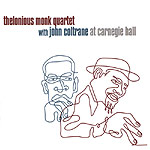
|
|||
|
|||
| Home |
| Gallery |
| Culture/ Technology |
| Fiction |
| Music |
| Poetry |
| Theater |
| What's New |
| About/Contact |
| Archive |
|
A hidden treasure, discovered Reviewed March 2006
Try this experiment: Walk into any shopping mall, or trendy coffee shop or bar, and ask twenty-five people what they know about Thelonious Monk. The guess here is you might find one or two with a clue; most of the rest of them will think you're putting them on. "Thelonious who?" might be a common reply. Pianist/composer Thelonious Sphere Monk, for those in the Thelonious Who section, was one of American's most distinctive jazz pioneers. He laid down dozens of his classic compositions ("In Walked Bud," "Well You Needn't," "Ruby My Dear," "'Round Midnight" ...) on Blue Note Records in the late 1940s and very early '50s, alongside other giants like Sonny Rollins, Bud Powell and Miles Davis. He then recorded briefly for Prestige Records in the '50s before moving to Riverside Records stable, but didn't achieve major recognition outside the jazz community until he signed with Columbia Records, where he recorded and released "Monk's Dream" in 1962. If you try this shopping mall experiment with the name John Coltrane, you might have better – though still not great – results. Coltrane was the guy who played tenor saxophone with the Miles Davis Sextet on the 1959 classic "Kind of Blue." He put out his own batch of fine albums on Prestige in the late '50s, then went looking for God with his saxophone, and damned near found Him on his masterpiece "A Love Supreme." Both artists were one-of-a-kind musical individuals – Monk with his jagged, joyful and somtimes dissonant style, a percussive approach to the keyboard that was full of sharp angles and quirky surprises; Coltrane, on tenor saxophone, possessed huge technical skills, nearly unmatched power, and one of the most serching minds in jazz. And for an all-too-brief few months in 1957, he played in Monk's quartet, a stint that was sadly under-recorded, with just the "Thelonious Monk with John Coltrane" on Prestige in '58, that contained only three Monk/Coltrane teamings; and "Monk's Music" (Riverside Records, '57), an excellent septet session where 'Trane was joined by Coleman Hawkins and Gigi Gryce – tenor and alto saxes – and trumpeter Ray Copeland in the front line. But there really is such a thing as hidden treasure. In February 2005, Larry Appelbaum, a jazz specialist for the Library of Congress, found a long lost tape of the Monk Quartet with John Coltrane, recorded live at a benefit concert at Carnegie Hall, Dec. 24, 1957. The music is fifty-one minutes of collaborative genius. In 1957, most of Monk's classic songs had been written, but he was at the height of his powers in terms of performance. The set opens with "Monk's Mood," one of his more introspective compositions. For the first two minutes it's unaccompanied piano, Monk looking inward with the delicately pretty melody. Then in blows Coltrane, his "sheets of sound" style in full display. And while we know of Monk's influence on the younger musician, the pianist in turn sounds inspired by 'Trane's sound, cascading notes up and down the scales in response to the saxophone explorations. The discovery of that tune alone would be cause for celebration, but the entire show was recorded, except for the ending of Monk's showcloser, "Epistrophy." In additon to "Monk's Mood," there's "Evidence," "Crepuscule with Nellie," "Nutty," "Bye-Ya," a full version of "Epistrophy" (closing out the first of the two sets), one non-Monk tune, the standard "Sweet and Lovely," and "Blue Monk." "Thelonious Monk Quartet with John Coltrane Live at Carnegie Hall," recorded in 1957, showcases an established jazz genius and an emerging one, in one of the most inspired live jazz concerts on record, ever. Finally! Review by Dan McClenaghan. Dan is a writer living in Oceanside, Calif. Read his biography on his AllAboutJazz.com page. |
Copyright © Turbula.net

